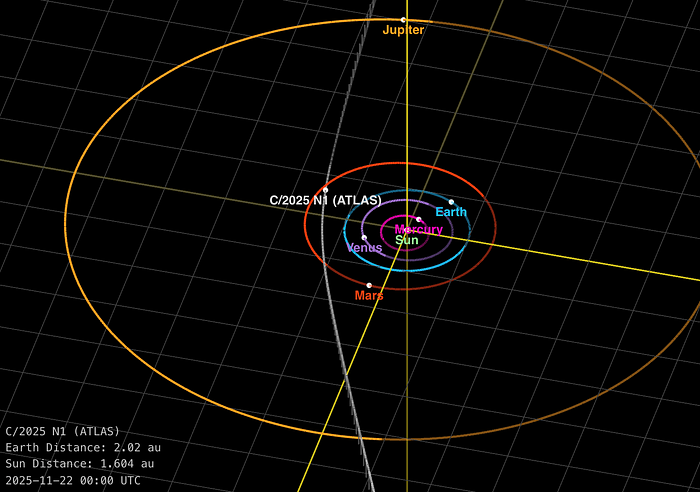
Trajectory of 3I/ATLAS with positions of the planets on November 22, 2025. (Credit: NASA/JPL)
Avi Loeb
Let us suppose, hypothetically, that the interstellar object 3I/ATLAS is a mothership that was designed to seed Jupiter with technological devices. What would be the largest distance from Jupiter that this interstellar gardener should arrive at?
For that purpose, 3I/ATLAS must arrive within Jupiter’s radius of gravitational influence — the so-called Hill radius, inside of which Jupiter’s gravity overcomes the gravitational tide from the Sun. Interior to that radius, Jupiter’s gravity wins over the Sun’s gravity and can keep low-speed orbiters bound without the Sun ripping them away. The Lagrange points L1 and L2 of force equilibrium are located at the Hill radius and are ideal locations for technological satellites, since orbital corrections and fuel requirements are minimal there.
Jupiter’s Hill radius is given by the equation:
H=R*(m/3M)^{1/3},
where R is Jupiter’s distance from the Sun at the particular time of interest, m is Jupiter’s mass and M is the Sun’s mass.
3I/ATLAS is expected to get to its closest distance from Jupiter on March 16, 2026. The Jupiter-Sun separation on that date will be R=783.8 million kilometers. Substituting this value in the above equation together with (m/3M)^{1/3}=0.06826, yields the Hill radius of Jupiter on March 16, 2026:
H=53.502 million kilometers.
The distance of closest approach of 3I/ATLAS to Jupiter is calculated by NASA’s JPL Horizons code based on orbital data gathered by about 230 observatories regarding its motion in the sky. This data includes the recently measured non-gravitational acceleration of 3I/ATLAS during perihelion, leading JPL Horizons to forecast that on March 16, 2026 3I/ATLAS will arrive at the following minimum distance from Jupiter:
Min{D}= 53.445 (+/- 0.06) million kilometers
What an extraordinary coincidence. The values of H and min{D} are identical within one standard deviation of 0.06 million kilometers. The near coincidence of these numbers was brought to my attention by Steve Fairfax.
The measured value of the non-gravitational acceleration of 3I/ATLAS, acquired during the month-long passage of 3I/ATLAS near perihelion, changed the value of min{D} at a level of 0.1 million kilometers. This magnitude of displacement in the minimum distance of 3I/ATLAS from Jupiter results from the measured non-gravitational acceleration value of 5×10^{-7} au per day squared as reported here, after the month-long perihelion crossing (where au is the Earth-Sun separation).
In other words, the non-gravitational acceleration introduced a small course correction of exactly the magnitude needed to bring the minimum distance of 3I/ATLAS from Jupiter to the value of Jupiter’s Hill radius. 3I/ATLAS would have missed the edge of the Hill sphere otherwise.
This suggests that the level of non-gravitational acceleration was finely tuned to result in min{D}=H and bring 3I/ATLAS exactly to the radius of Jupiter’s gravitational influence.
If 3I/ATLAS is technological in origin, it might have fine-tuned its trajectory with the help of thrusters so as to arrive at Jupiter’s Hill radius. In that case, the multiple jets observed around 3I/ATLAS in its post-perihelion images (as reported here, here, here and here) might have been used for the slight orbit correction needed to result in min{D}=H. The optimal time for any such maneuver is close to perihelion when a spacecraft can take advantage of the gravitational assist from the Sun (as pointed out here). In addition, 3I/ATLAS arrived at perihelion while being hidden behind the Sun for Earth-based observatories. We therefore do not know whether it just maneuvered slightly to satisfy min{D}=H or also released technological devices near perihelion.
How statistically rare is the coincidence between the values of min{D} and H? A margin of 0.06 out of 53.5 million kilometers corresponds to a coincidence of one part in a thousand. But given the full diameter of Jupiter’s orbit around the Sun, this coincidence amounts to one part in 26,000.
If 3I/ATLAS were to deposit devices within the Hill sphere of Jupiter on March 16, 2026, these devices would need to fire their engines in order to cancel out the high speed of 3I/ATLAS relative to Jupiter, which is 65.9 kilometers per second. The escape speed from Jupiter’s gravitational potential well at H=53.5 million kilometers is just 2.2 kilometers per second.
Any new objects orbiting Jupiter after the passage of 3I/ATLAS, could be identified by the Juno spacecraft (as discussed here) or by other human-made orbiters around Jupiter. If we find technological satellites of Jupiter that we did not send, it would imply that Jupiter is of interest to an extraterrestrial civilization. Not finding similar gadgets near Earth might be disappointing because it would suggest that our interstellar guest is not interested in us. Not only that we are not at the center of the Solar system, but we are also not at the center of attention of our cosmic neighborhood. This will deliver a blow to our ego, akin to attending a party where nobody is interested in dancing with us. Perhaps this is because the human species arrived late to the party — only a few million years ago, whereas Jupiter — the biggest planet in the Solar system, was visible to the senders of 3I/ATLAS when the mission was launched billions of years ago.
After all, most stars formed billions of years before the Sun and it would take 3I/ATLAS a billion years to cross the Milky-Way disk. Here’s hoping that when our own interstellar spacecraft reach their target planetary systems, the press conference held by space officials there will not refer to our technological products as “definitely comets!”, based on the ices and dust that accumulated on their surface during their journey through the cold interstellar medium.
____
https://avi-loeb.medium.com/a-remarkable-new-anomaly-of-3i-atlas-420065c2cddf
